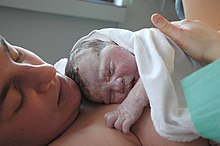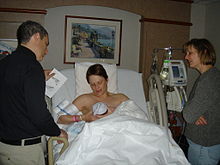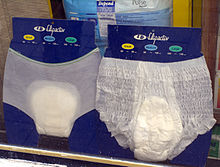8 Week Postpartum and Getting Tubes Tied and Bleeding Again

The postpartum (or postnatal) period begins immediately later childbirth every bit the mother's torso, including hormone levels and uterus size, returns to a non-pregnant state.[1] The terms puerperium, puerperal period, or immediate postpartum period are normally used to refer to the get-go six weeks following childbirth.[2] The World Wellness Organization (WHO) describes the postnatal flow as the most critical and yet the nigh neglected stage in the lives of mothers and babies; most maternal and newborn deaths occur during this period.[3]
In scientific literature, the term is usually abbreviated to Px , where x is a number; for instance, "solar day P5" should exist read as "the fifth twenty-four hours after nascence". This is not to be dislocated with the medical classification that uses G P to stand for number and outcomes of pregnancy (gravidity and parity).
A woman giving nascence in a hospital may leave equally soon as she is medically stable, which tin can be as early as a few hours postpartum, though the boilerplate for a vaginal birth is one to ii days. The average caesarean section postnatal stay is three to 4 days.[4] During this time, the mother is monitored for haemorrhage, bowel and bladder function, and infant care. The infant's health is also monitored.[v] Early postnatal hospital belch is typically defined as discharge of the mother and newborn from the hospital within 48 hours of birth.
The postpartum menstruation tin be divided into three distinct stages; the initial or acute phase, 8–xix hours after childbirth; subacute postpartum menses, which lasts two to 6 weeks, and the delayed postpartum period, which tin can final up to viii months.[ii] In the subacute postpartum period, 87% to 94% of women study at least one health problem.[six] [7] Long-term health problems (persisting after the delayed postpartum menstruation) are reported past 31% of women.[8]
Various organizations recommend routine postpartum evaluation at certain time intervals in the postpartum period.[9]
Acute phase [edit]

Baby placed directly on the chest following childbirth

Postpartum uterine massage helps the uterus to contract later the placenta has been expelled in the acute phase.
The outset 6 to 12 hours after childbirth is the initial or acute phase of the postpartum period.[two] During this fourth dimension the mother is typically monitored by nurses or midwives as complications can arise.
The greatest health chance in the astute stage is postpartum bleeding. Post-obit commitment the area where the placenta was attached to the uterine wall bleeds, and the uterus must contract to prevent claret loss. After contraction takes place the fundus (top) of the uterus can be palpated as a firm mass at the level of the bellybutton. It is important that the uterus remains house and the nurse or midwife will brand frequent assessments of both the fundus and the amount of bleeding. Uterine massage is usually used to assist the uterus contract.[x]
Following delivery if the mother had an episiotomy[11] or vehement at the opening of the vagina, information technology is stitched. In the past, an episiotomy was routine. However, more contempo inquiry shows that routine episiotomy, when a normal delivery without complications or instrumentation is anticipated, does not offer benefits in terms of reducing perineal or vaginal trauma. Selective use of episiotomy results in less perineal trauma.[12] A healthcare professional can recommend comfort measures to assist to ease perineal pain[ten]
Infant caring in the acute stage [edit]

Baby nursing shortly subsequently birth

Woman nurses twins half dozen days after birth. The linea nigra is notwithstanding visible.
Within virtually 10 seconds the babe takes its offset breath and the caregiver places the babe on the mother's chest. The baby'south status is evaluated using the Apgar scale.[13] The Apgar score is adamant by evaluating the newborn baby on v criteria which are summarized using words chosen to form an acronym (Appearance, Pulse, Grimace, Activity, Respiration). Until recently babies were routinely removed from their mothers following birth; however beginning effectually 2000, some authorities began to propose that early on skin-to-peel contact (placing the naked babe on the mother's chest) is of benefit to both mother and infant. Equally of 2014, early peel-to-skin contact, also called kangaroo intendance, is endorsed past all major organizations that are responsible for the well-being of infants. Thus, to help establish bonding and successful breastfeeding, the caregiver carries out immediate mother and infant assessments every bit the infant lies on the female parent's chest and removes the infant for farther observations only after they have had their start breastfeed, depending on the mother'due south preference. The Earth Health Organization (WHO) also encourages peel-to-skin contact for the first 24 hours later on birth to aid regulate the infant's temperature.[14]
Subacute postpartum period [edit]
The subacute postpartum starts after the acute postpartum catamenia concludes and tin concluding for two to 6 weeks.[two]
Concrete recovery in the subacute postpartum period [edit]
In the first few days following childbirth, the take chances of a deep vein thrombosis (DVT) is relatively high equally hypercoagulability increases during pregnancy and is maximal in the postpartum period,[15] particularly for women with C-section with reduced mobility. Anti-coagulants or physical methods such as compression may be used in the hospital, specially if the woman has run a risk factors, such as obesity, prolonged immobility, recent C-department, or beginning-degree relative with a history of thrombotic episode. For women with a history of thrombotic event in pregnancy or prior to pregnancy, anticoagulation is generally recommended.[16]
The increased vascularity (blood catamenia) and edema (swelling) of the woman'due south vagina gradually resolves in almost three weeks.[ commendation needed ] The cervix gradually narrows and lengths over a few weeks.[17] Postpartum infections can lead to sepsis and if untreated, death.[18] Postpartum urinary incontinence is experienced by almost 33% of all women; women who evangelize vaginally are virtually twice as likely to have urinary incontinence equally women who give birth via a cesarean.[19] Urinary incontinence in this menses increases the risk of long term incontinence.[2] Kegel exercises are recommended to strengthen the pelvic floor muscles and control urinary incontinence.[20]

Adult diapers may be worn in the subacute postpartum period for lochia, also equally urinary and fecal incontinence.
Discharge from the uterus, chosen lochia, will gradually subtract and turn from brilliant red, to chocolate-brown, to yellow and finish at around five or 6 weeks. Women are advised in this menstruum to wear developed diapers or nappies, disposable maternity briefs, motherhood pads or towels, or germ-free napkins. The employ of tampons or menstrual cups are contraindicated as they may introduce leaner and increment the risk of infection.[21] An increment in lochia between 7–14 days postpartum may signal delayed postpartum hemorrhage.[1]
Hemorrhoids and constipation in this flow are mutual, and stool softeners are routinely given.[22]
In the subacute postpartum flow, 87% to 94% of women study at least ane health problem.[6] [7]
Babe caring in the subacute period [edit]
At two to four days postpartum, a adult female's breastmilk will mostly come in.[23] Historically, women who were non breastfeeding (nursing their babies) were given drugs to suppress lactation, just this is no longer medically indicated. In this menstruum, difficulties with breastfeeding may ascend. Maternal sleep is often disturbed equally night waking is normal in the newborn, and newborns need to exist fed every ii to three hours, including during the night.[24] The lactation consultant, wellness company, monthly nurse, postnatal doula, or kraamverzorgster may be of help at this time.
Psychological disorders [edit]
During the subacute postpartum menstruum, psychological disorders may sally. Among these are postpartum depression, posttraumatic stress disorder, and in rare cases, postpartum psychosis.[25] Postpartum mental illness can affect both mothers and fathers, and is non uncommon.[26] Early on detection and acceptable handling is required. Approximately seventy-fourscore% of postpartum women volition experience the "baby dejection" for a few days. Between 10 and twenty percent may experience clinical depression, with a higher risk amongst those women with a history of postpartum depression, clinical low, feet, or other mood disorders.[27] Prevalence of PTSD following normal childbirth (excluding stillbirth or major complications) is estimated to exist betwixt 2.8% and 5.6% at six weeks postpartum.[28]
Maternal-babe postpartum evaluation [edit]
Various organizations across the world recommend routine postpartum evaluation in the postpartum period. The American College of Obstetricians and Gynecologists (ACOG) recognizes the postpartum menses (the "fourth trimester") as critical for women and infants. Instead of the traditional single four- to six-week postpartum visit, ACOG, equally of 2018, recommends that postpartum care be an ongoing procedure. They recommend that all women have contact (either in person or by telephone) with their obstetric provider within the commencement 3 weeks postpartum to address astute issues, with subsequent care every bit needed. A more than comprehensive postpartum visit should be washed at four to twelve weeks postpartum to address the mother'south mood and emotional well-being, physical recovery after nascency, infant feeding, pregnancy spacing and contraception, chronic disease direction, and preventive health care and health maintenance. Women with hypertensive disorders should have a blood force per unit area bank check within three to ten days postpartum. More than one half of postpartum strokes occur inside 10 days of discharge afterward delivery. Women with chronic medical (east.thousand., hypertensive disorders, diabetes, kidney disease, thyroid illness) and psychiatric conditions should continue to follow with their obstetric or main care provider for ongoing disease management. Women with pregnancies complicated by hypertension, gestational diabetes, or preterm birth should undergo counseling and evaluation for cardiometabolic disease, as lifetime risk of cardiovascular disease is higher in these women.[ix]
Similarly, the World Health Organization recommends postpartum evaluation of the mother and infant at three days, one to two weeks, and six weeks postpartum.[9]
Delayed postpartum period [edit]
The delayed postpartum period starts after the subacute postpartum period and lasts up to 6 months.[2] During this time, muscles and connective tissue returns to a pre-pregnancy state. Recovery from childbirth complications in this period, such every bit urinary and fecal incontinence, painful intercourse, and pelvic prolapse, are typically very irksome and in some cases may not resolve.[ii] Symptoms of PTSD frequently subside in this period, dropping from two.eight% and v.half-dozen% at half dozen weeks postpartum to one.v% at six months postpartum.[28] [29]
Approximately 3 months after giving birth (typically between 2 and 5 months), estrogen levels drop and big amounts of hair loss is common, particularly in the temple surface area (postpartum alopecia). Hair typically grows dorsum unremarkably and handling is not indicated.[30] [31] Other conditions that may arise in this period include postpartum thyroiditis.
During this menstruum, infant sleep during the nighttime gradually increases and maternal sleep generally improves.[24]
Long-term wellness issues (persisting after the delayed postpartum catamenia) are reported by 31% of women.[8]
Ongoing physical and mental health evaluation, hazard gene identification, and preventive wellness care should be provided, as detailed above .
Cultures [edit]

A mother in Florence lying-in, from a painted desco da parto or birth tray of c. 1410. Equally women tend to the child, expensively dressed female person guests are already arriving.
Postpartum confinement refers to a system for recovery following childbirth. It begins immediately afterward the birth, and lasts for a culturally variable length: typically for 1 month or 30 days,[32] up to 40 days, two months or 100 days.[33] This postnatal recuperation tin include "traditional wellness beliefs, taboos, rituals, and proscriptions."[34] The exercise used to be known as "lying-in", which, as the term suggests, centres around bed residue. (Maternity hospitals used to utilize this phrase, every bit in the General Lying-in Hospital.) Postpartum confinement customs are well-practiced in China, where it is known every bit "Sitting the month", and similar customs manifest all over the world. A modern version of this balance period has evolved, to give maximum support to the new mother, especially if she is recovering from a difficult labour and delivery.[ not specific enough to verify ]
See besides [edit]
- Postpartum physiological changes
- Puerperal disorder
- Doula
- Parental leave
- Sex after pregnancy
References [edit]
- ^ a b Kansky C (July 2016). "Normal and Abnormal Puerperium: Overview, Routine Postpartum Care, Hemorrhage". Medscape.
- ^ a b c d e f grand Romano K, Cacciatore A, Giordano R, La Rosa B (May 2010). "Postpartum period: three distinct but continuous phases". Periodical of Prenatal Medicine. 8 (5): xv–ii. doi:ten.1002/anie.201108814. PMC3279173. PMID 22438056.
- ^ "WHO Recommendations on Postnatal Care of the Female parent and Newborn". World Health Arrangement. 2013. Retrieved 12 March 2022.
- ^ "Recovering from a caesarean section". NHS Choices . Retrieved sixteen Dec 2016.
- ^ Vernon D (2007). With Women, Midwives Experiences: from Shiftwork to Continuity of Care. Canberra: Australian College of Midwives. p. 17. ISBN978-0-9751674-v-8.
- ^ a b Glazener CM, Abdalla Grand, Stroud P, Naji S, Templeton A, Russell It (April 1995). "Postnatal maternal morbidity: extent, causes, prevention and handling". British Journal of Obstetrics and Gynaecology. 102 (4): 282–vii. doi:ten.1111/j.1471-0528.1995.tb09132.x. PMID 7612509. S2CID 38872754.
- ^ a b Thompson JF, Roberts CL, Currie Grand, Ellwood DA (June 2002). "Prevalence and persistence of health issues afterward childbirth: associations with parity and method of birth". Birth (Berkeley, Calif.). 29 (2): 83–94. doi:ten.1046/j.1523-536X.2002.00167.x. PMID 12051189.
- ^ a b Borders N (2006). "Afterward the afterbirth: a critical review of postpartum health relative to method of delivery". Periodical of Midwifery & Women's Health. 51 (four): 242–248. doi:10.1016/j.jmwh.2005.10.014. PMID 16814217.
- ^ a b c "ACOG Committee Opinion: Optimizing Postpartum Care". May 2018. Retrieved April 29, 2020.
- ^ a b Mayo Clinic staff (30 July 2015). "Labor and delivery, postpartum care". Mayo Dispensary. Retrieved 15 August 2015.
- ^ Romano, Mattea; Cacciatore, Alessandra; Giordano, Rosalba; La Rosa, Beatrice (2010). "Postpartum menstruation: three singled-out just continuous phases". Journal of Prenatal Medicine. 4 (2): 22–25. ISSN 1971-3282. PMC3279173. PMID 22439056.
- ^ Jiang, Hong; Qian, Xu; Carroli, Guillermo; Garner, Paul (2017). "Selective versus routine use of episiotomy for vaginal birth". Cochrane Database of Systematic Reviews. 2017 (2): CD000081. doi:10.1002/14651858.CD000081.pub3. PMC5449575. PMID 28176333. Retrieved 2020-05-eighteen .
- ^ "The Apgar Score". www.acog.org . Retrieved 2021-03-04 .
- ^ Phillips R. "Uninterrupted Skin-to-Skin Contact Immediately Later on Birth". Medscape . Retrieved 21 December 2014.
- ^ Fiengo 50, Bucci F, Patrizi One thousand, Giannotti D, Redler A (February 2013). "Postpartum deep vein thrombosis and pulmonary embolism in twin pregnancy: undertaking of clinical symptoms leading to massive complications". Thrombosis Periodical. eleven (1): 4. doi:10.1186/1477-9560-11-4. PMC3629711. PMID 23433174.
- ^ American College of Obstetricians Gynecologists' Committee on Practice Bulletins—Obstetrics (July 2018). "ACOG Practice Message No. 196: Thromboembolism in Pregnancy". Obstetrics & Gynecology. 132 (1): e1–e17. doi:x.1097/AOG.0000000000002706. ISSN 0029-7844. PMID 29939938. S2CID 49404670.
- ^ "Childbirth recovery and postpartum care". world wide web.aboutkidshealth.ca . Retrieved 2018-04-22 .
- ^ WHO (2013). "WHO recommendations on postnatal care of the mother and newborn". World Health Arrangement. Archived from the original on 22 December 2014. Retrieved 22 December 2014.
- ^ Thom DH, Rortveit G (December 2010). "Prevalence of postpartum urinary incontinence: a systematic review". Acta Obstetricia et Gynecologica Scandinavica. 89 (12): 1511–22. doi:ten.3109/00016349.2010.526188. PMID 21050146. S2CID 18385231.
- ^ "Postpartum care: After a vaginal delivery". Mayo Clinic . Retrieved 2020-05-18 .
- ^ Northward. H. S. Choices (2017-07-20). "How soon tin I use tampons afterwards giving birth?". N.H.S. Choices . Retrieved 2018-04-22 .
- ^ "Postpartum hemorrhoids". Babe Centre . Retrieved 2018-05-19 .
- ^ "Breastfeeding: the first few days". www.nhs.uk. 2017-12-21. Retrieved 2018-04-22 .
- ^ a b McGuire E (July 2013). "Maternal and infant sleep postpartum". Breastfeeding Review. 21 (2): 38–41. PMID 23957180.
- ^ Dobson V, Sales B (2000). "The Science of Infanticide and Mental Disease". Psychology, Public Policy, and Police force. half dozen (4): 1098–1112. doi:x.1037/1076-8971.6.4.1098.
- ^ "Postpartum Low". Canadian Mental Health Association . Retrieved July ix, 2014.
- ^ "Statistics on Postpartum Depression - Postpartum Depression Resources". PostpartumDepression.org . Retrieved 2020-05-eighteen .
- ^ a b Olde E, van der Hart O, Kleber R, van Son M (Jan 2006). "Posttraumatic stress following childbirth: a review". Clinical Psychology Review. 26 (1): 1–16. doi:10.1016/j.cpr.2005.07.002. hdl:1874/16760. PMID 16176853.
- ^ Alder J, Stadlmayr West, Tschudin S, Bitzer J (June 2006). "Post-traumatic symptoms after childbirth: what should nosotros offer?". Journal of Psychosomatic Obstetrics and Gynaecology. 27 (2): 107–12. doi:10.1080/01674820600714632. PMID 16808085. S2CID 21859634.
- ^ SCHIFF, BENCEL L. (1963-05-01). "Report of Postpartum Alopecia". Archives of Dermatology. 87 (5): 609–xi. doi:10.1001/archderm.1963.01590170067011. ISSN 0003-987X. PMID 13991677.
- ^ Eastham, John H (February 2001). "Postpartum Alopecia". The Annals of Pharmacotherapy. 35 (ii): 255–258. doi:x.1345/1542-6270(2001)035<0255:pa>2.0.co;two. ISSN 1060-0280. PMID 11215848.
- ^ Chien YC, Huang YJ, Hsu CS, Chao JC, Liu JF (March 2009). "Maternal lactation characteristics afterward consumption of an alcoholic soup during the postpartum 'doing-the-calendar month' ritual". Public Health Diet. 12 (3): 382–eight. doi:ten.1017/S1368980008002152. PMID 18426631.
- ^ "Confinement practices: an overview". BabyCenter . Retrieved 2016-03-21 .
- ^ Tung W (22 June 2010). "Doing the Month and Asian Cultures: Implications for Wellness Care". Dwelling house Wellness Care Direction & Practice. 22 (five): 369–371. CiteSeerX10.1.1.1020.5139. doi:10.1177/1084822310367473. S2CID 73055081.
External links [edit]
- eMedicine: Normal and Aberrant Puerperium
- Patient United kingdom of great britain and northern ireland: Postnatal Care (Puerperium)
- NHS Choices Birth to Five Planner: Postnatal post-traumatic stress disorder
- Postpartum intendance of mother and newborn: WHO
- Postpartum period: First six Weeks After Childbirth- Uofmhealth
bradfordhatessuce.blogspot.com
Source: https://en.wikipedia.org/wiki/Postpartum_period